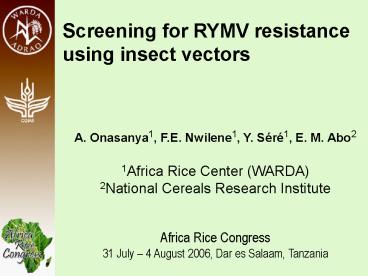Screening for RYMV resistance using insect vectors PowerPoint PPT Presentation
1 / 24
Title: Screening for RYMV resistance using insect vectors
1
Screening for RYMV resistance using insect
vectors A. Onasanya1, F.E. Nwilene1, Y. Séré1,
E. M. Abo2 1Africa Rice Center (WARDA) 2National
Cereals Research Institute Africa Rice
Congress 31 July 4 August 2006, Dar es Salaam,
Tanzania
2
OUTLINE
Introduction Management Strategy Key
Issues Methodology Results Summary The Way
Forward
3
Distribution of RYMV in Africa
Burkina Faso
Mauritania
Mali
Senegal
Chad
Niger
Gambia
Guinea Bissau
Guinea
Sierra Leone
Benin
Liberia
Ghana
Kenya
Togo
Côte dIvoire
Rwanda
Tanzania
Nigeria
Cameroon
Madagascar
Countries with RYMV incidence
Endemic countries
4
Strategy for Integrated Management of RYMV
Cultural practices
Varietal resistance
Vector management
Alternative host management
5
How is the virus transmitted? The virus is
mechanically transmitted gains entry into rice
plants through injuries. The possible roots of
entry are ?Root damage during transplanting and
roots intertwining in the soil ?Weeding
operations with hoes ?Harvesting with
sickle ?Insects
6
Why focus on insect vectors ?
The insect species
feed on an infected plant
1
collect the virus particles
2
pass them on to the next plant that they feed on
3
The virus does not undergo any changes within the
insect itself, but simply uses it as a vehicle
7
Insect vectors of RYMV
Trichispa sericea
Oxya hyla
Chaetocnema pulla
Locris rubra
Conocephalus longipennis
Chnootriba similis
8
Nature of damage of rice leaves by vectors
4. Chnootriba similis 5. Conocephalus longipennis
- Chaetocnema pulla
- Trichispa sericea
- Oxya hyla
5
1
4
2
3
9
Key Issues
- High yielding rice varieties with stable
resistance to RYMV are not yet available
- Why do we want to modify our screening
methodology by using insect vectors in place of
conventional mechanical inoculation ? - Why in a uniform field of rice, only some plants
become diseased ?
10
Methodology
Differential rice genotype used
11
Identity of RYMV isolates from Nigeria
12
Virulent strain selection
- 3 isolates ( I1, I7 I8 ) were highly pathogenic
and virulent - I7 isolate was selected for use in insect vector
screening study
13
Insect species capable of transmitting RYMV from
rice plants to alternative (weed) hosts after 48
hrs acquisition feeding period
Alternative (weed) hosts
Insect species
Control
Perennial
Annual
Imc
Leh
Olo
Ecp
Eco
Bra
Elu
Dig
B189
L.F. beetles
Chaetocnema pul.
Trichispa seric.
Chnootriba simil.
Cheilomenes
L.F. g/hopper
Conocephalus
Oxya hyla
Euscyrtus
Parattetix
Zonocerus
Sucking bug
Cofana spectra
Cofana unim.
Locris rubra
14
Methodology (cont.)
- Experimental design RCB with 3 replications
- Insect vector used Oxya hyla reared on BG-2 in
a paddy screen house
- Cultivar used 8 differential rice genotypes
- Infected rows BG 90-2
- RYMV Isolate I7 from Nigeria
- Data collection (42 days after inoculation)
- - disease incidence (visual score on a scale of
1-9) - viral content (ELISA)
- yield reduction
15
Infected rows (BG 90-2)
Test entries
16
Results
ANOVA for viral content (VC), disease incidence
(DI) and Yield reduction (YR)
ns not significant significant at 5
level significant at 1
level
17
Mean comparison for viral content
18
Mean comparison for disease incidence
19
Mean comparison for yield reduction
20
Summary
Screening with mechanical inoculation
produced 7.8 viral content 45.5 disease
incidence 77.8 yield reduction
Screening with insect vector produced 45.2
viral content 21.7 disease incidence 41.1
yield reduction
21
Summary (cont.)
- Insect vector was able to transmit higher viral
content than the mechanical inoculation method - Virus pathogenicity (disease incidence and yield
reduction) was higher in mechanical inoculation
method than in the insect vector
22
The Way Forward
This preliminary study revealed the possibility
and potential of using insect vector to screen
for durable resistance to RYMV. However,
information on other vector species is needed to
further confirm its potential
23
Thank you Merci Asante sana Obrigado Melesi
24
Levels of resistance / susceptibility RYMV
Evaluation System (IITA, 1986)
Flowering
Reduction in plant height
Leaf color
Resistant type
Visual score
normal
nil
green
1
High.resistant
normal
lt5 reduction
Green leaves with sparse dots
Resistant
3
Slightly delayed
6-25
Pale green with mottling
Moderately resistant
5
delayed
26-75
Pale yellow leaves
7
Susceptible
No flowering or some plants dead
gt75
Leaves turn yellow orange
Highly susceptible
9

